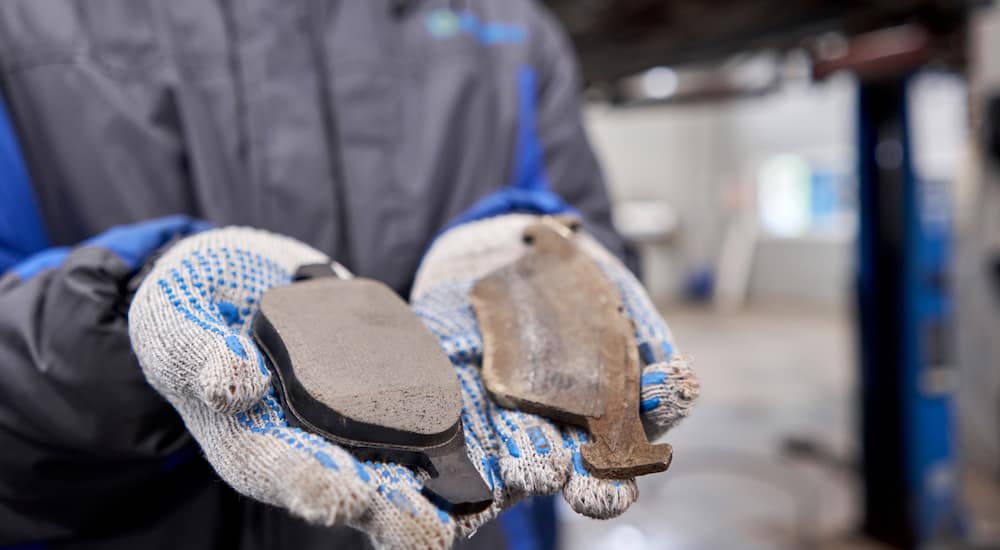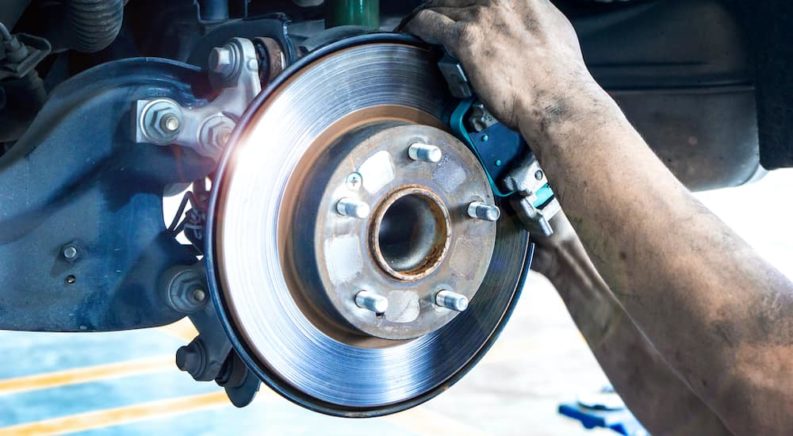With any fast car, stopping power is essential. For Nissan’s high-performance Z cars, this axiom is doubly true, and any owner of a Z that plans to track their car knows to keep their brakes in peak condition. While Nissan brake service at your local Nissan dealership will keep your Z ready for street driving or autocross runs, it is recommended to upgrade your brakes if you are planning serious track use.
As a sports car, a 350Z or 370Z’s braking system is optimized from the factory for spirited street use. This essentially means having fun and using the sports cars as they were intended. The factory Z car hardware can handle more than this for short periods at a time, but if a driver intends to go above and beyond and competitively track their Z, the brakes should be upgraded to maintain the same margin of safety.
The reason a track-deployed Z needs upgraded brakes is, in a word, heat. Disc brakes work by converting rotational kinetic energy into heat. A factory braking system is only designed to handle so much heat at a time before it begins to lose effectiveness, while an upgraded system can handle much more.
On the street, you will never stop from high speed more than once in succession. During a 20-minute track day session, depending on the track in question, the car will decelerate from very high speed a dozen times or more. That is roughly the practical limit to factory brakes, which will need a significant cool-down period after each session.
Upgraded brakes are a small and worthwhile investment if one intends to do more intense driving than introductory track days, and in many cases, even as a general upgrade before you hit the track at all.
Brake System Overview
The disc brakes used on all modern passenger cars are paragons of simplicity, effectiveness, and reliability. Overall, five parts are used to convert huge amounts of rotational kinetic energy into heat, and they can do so in practically any weather condition and will work without issue for years.
Those five parts under each corner of the car are the rotors, calipers, pads, lines, and fluid. The rotors spin with the wheels and are used to dissipate the heat generated when braking. The calipers are stationary and positioned over the rotors, holding the pistons that push the pads into the rotors to perform braking. The pads are where the rubber meets the road, or more literally, where the pad material meets the rotor. When the brake pedal is pressed, the pads are shoved into the rotor by the pistons in the caliper, pinching the spinning disc and forcing it to slow down. The brake lines are how brake fluid travels into the caliper and allow the whole system to actuate on command.
The rotors, pads, and fluid are the most important parts of that system, and all of them are susceptible to the amount of heat generated by heavy track use. That is where upgrades come in.

Upgrading Brake Pads
Brake pads are the most important part of the braking system for most light track and autocross use. On a modern sports car like the 350Z or 370Z, the brake fluid is the only other common “weak” point when pursuing that required braking capability on the track. Upgraded performance pads tend to make more noise than factory units but will handle significantly more heat than their more docile siblings.
The best modern brake pads maintain near-factory levels of refinement on the street while at the same time offering enough heat resistance on track to keep the brakes performing at their peak in a track day setting. However, when moving from track days to competition, the extreme heat may require special pads that are poorly suited for street use where they will not have time to warm up to their designed operating temperatures.
Upgrading Brake Lines and Fluid
Often overlooked, the brake lines and the fluid that runs through them are what actually actuate the brakes when the brake pedal is pressed. On older vehicles, replacing the factory rubber brake lines with aftermarket steel lines is a common and understandable upgrade. However, on a modern Z car like a 350Z or 370Z, the stock brake lines are not only still fresh but are made of sterner stuff than what came on cars two or three decades ago.
What should be changed and bled before even a track day is the brake fluid. The most heat-sensitive part of just about any braking system, factory brake fluid meant for the street rarely holds up under the pressures of track use. This will lead to a spongy pedal feel and eventually loss of overall braking performance. High-performance brake fluid will solve that problem with very little effort.
Upgrading Brake Rotors
For drivers who only track their car for fun and not in competition, the factory rotors should actually hold up well. But the moment you go from light track day sessions to any kind of serious racing or competition, the rotors should be upgraded. Larger rotors have more surface area to spread heat out on, while slotted or drilled rotors include more locations designed to let heat escape. When properly designed, a slotted or drilled rotor maintains strength while using whatever surface area it has more efficiently than a blank rotor. Rotor material and construction also matter, and some brake kits allow the system to tolerate far more heat while both improving braking force and reducing weight.
Unsprung weight, that is, weight not carried by the suspension, actually has an outside effect on performance. The rotor, wheel, and tire are all prime examples of unsprung weight, and the heavier they are, the harder it is to accelerate, brake, and turn. High-performance rotors not only improve the heat tolerance and stopping power of a braking system by being more capable but by being lighter.

Upgrading Brake Calipers
Generally speaking, if you are not opting for a full big brake kit, the calipers are one of the last parts that need to be individually upgraded. They perform a vital function in pressing the pads to the rotors, but when stopping a vehicle of a Z car’s relatively small size and weight, the factory units can generally do the task even in some competition scenarios. This is largely because repeatedly stopping from high speed is more about heat resistance than actual braking force. The need to upgrade calipers to apply more force to the pads only arises if the vehicle gains significant weight or is stopping from extreme speeds.
“Extreme,” in this case, means something like professional-level wheel-to-wheel GT4 racing or above street-class time attack racing. Stopping from 150 miles per hour is very different from stopping from 120 miles per hour. Upgraded calipers can also make the brake force applied to the pads through the pistons more even across the pad surface.
Good Brakes Let You Go Faster
Brakes may be simple, but they are critically important, especially on a vehicle intended to hurtle down a back straight with a hairpin at the end. Modern Nissan Z cars come with capable brake systems, but when you intend to hit the track, those systems may require minor adjustments and updates to provide the safe and secure experience a Z driver is looking for when howling past their competition.

